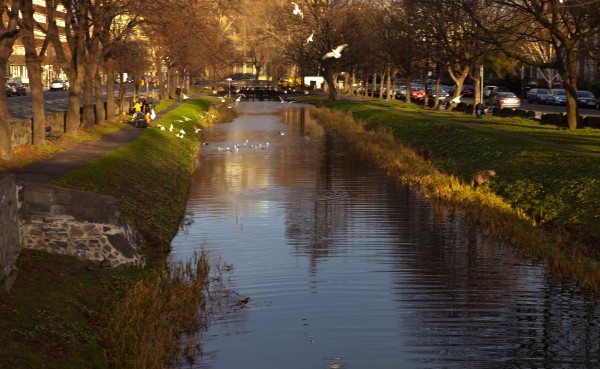
Did you happen to see those extraordinary beermats that were floating around pubs in the city centre last summer?
One of them depicted a salmon and explained how salmon support our river’s water chemistry and described how Liffey water is suitable for making Guinness; just as Rhine water enhances the production of Pilsner in Germany. The beermats were part of the Trinity Centre for Biodiversity Research (TCBR) team’s outreach tactic to explain to the wider public how biodiversity is linked to our everyday life. The TCBR also held pop-up talks in the pubs to add to the information on the beermats. “We are trying to bring ecological research to a wider audience, away from the ivory towers of Trinity and out of the hands of crusty hippies,” says Shane McGuinness, one of TCBR’s founders.
The team’s current outreach venture is free MP3 audio podcasts on 11 sites around Dublin, focusing on museums, waterways, parks and community gardens such as Irishtown Nature Park and the National History Museum. They illuminate the biological, economic, legal, social, and political aspects of each location. The podcasts are suitable for all ages and children will also find them entertaining. Dr Caoimhe Muldoon compiled all the biodiversity data on each place. They are intended to encourage biodiversity friendly activities in our own fair city. You can listen to the podcasts sitting comfortably at home. Alternatively, as half the people in Ireland now possess a smart phone, you can visit each site, on foot or on your bike and listen to them while looking around at what is being described. Aoife O’Rourke is the narrator on the podcast about Grand Canal and she tells us about the landscape, animals, fish, birds and snails that can be found there. Aoife advises us about anything to watch out for, such as the moorhens hiding in the vegetation on the banks and the pair of common terns who have been known to dive-bomb people walking by! The social history of the canal unfolds as Aoife tells us about Patrick Kavanagh’s statue and the history behind the barges.
These free-to-download podcasts plan to raise awareness and understanding of Dublin’s biodiversity and to showcase the all-encompassing biodiversity research being accomplished in our capital. The 11 sites in the podcasts are located between the Royal Canal and the Grand Canal. TCBR are now seeking funding which will allow them to provide additional podcasts on other areas of biodiversity interest. Caoimhe has “millions of ideas” for other settings, both inside and outside the canal boundaries. The only restriction for future podcasts unfortunately, is funding.
Biodiversity does not merely relate to animal and plant life, it includes everything we do in the city and how our actions as humans, influences and impacts on nature. City planners and developers to explain these inter-relationships often use the term ‘green infrastructure’, but the social sciences retain the term ‘biodiversity’. A very simple definition of biodiversity is: the diversity of plant and animal life in a particular habitat (or in the world as a whole). We, as humans, fall under the animal life research in the study.
Sir David Attenborough launched the department of the TCBR in 2008, a group of PhD students and staff from differing disciplines, who generously give their own time to the research. The areas of study range from botany and politics to geography and beyond. TCBR combines researchers from diverse fields of biodiversity study to broaden and enhance the knowledge base. Their study is threefold; they document and describe biodiversity, they follow ecology and ecosystem functioning, such as the impacts of climate change and how human action puts pressure on conservation and they collaborate with other research teams nationally and internationally. And although they have participated in biodiversity schemes in Thailand and Rwanda in the last year, Colin Stafford Johnson, who launched the biodiversity beermats initiative explains, “We need to conserve nature in our own country, even in the city, not just in far flung, exotic places”.
MP3 audio podcasts: www.tcd.ie/tcbr/biodiversity-audiotour
Facebook: https://www.facebook.com/trinitycentrebio?fref=ts
Twitter: https://twitter.com/TrinBio
By: Tracy O’Brien



